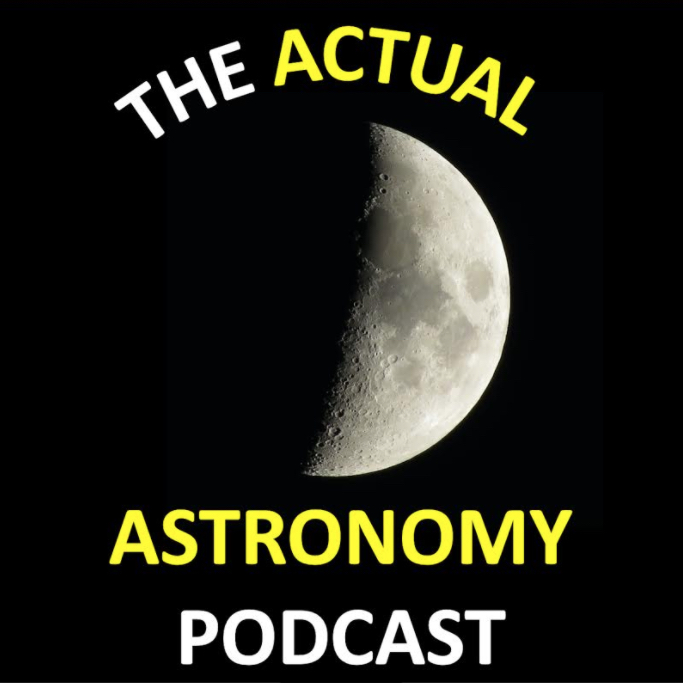Podcaster: Shane and Chris

Title: Episode 248: Saturn at Opposition
Organization: Actual Astronomy
Link : https://actualastronomy.podbean.com/
Description:
The Actual Astronomy Podcast presents Episode 248 Saturn at Opposition. In this episode we discuss how to find Saturn and what you can see with your eye, binoculars and a small telescope. We talk about the Rings and gaps in the rings, the Seelinger effect which brightens the rings around this time as well as the Moons of Saturn.
Bio: Shane and Chris are amateur astronomers who enjoy teaching astronomy classes and performing outreach where they help the eyes of the public to telescope eyepieces.
Today’s sponsor: Big thanks to our Patreon supporters this month: Rob Leeson, David Bowes, Brett Duane, Benett Bolek, Mary Ann, Frank Frankovic, Michael Freedman, Kim Hay, Steven Emert, Frank Tippin, Rani Bush, Jako Danar, Joseph J. Biernat, Nik Whitehead, Michael W, Cherry Wood, Steve Nerlich, Steven Kluth, James K Wood, Katrina Ince, Phyllis Foster, Don Swartwout, Barbara Geier, Steven Jansen, Donald Immerwahr
Please consider sponsoring a day or two. Just click on the “Donate” button on the lower left side of this webpage, or contact us at signup@365daysofastronomy.org.
Please visit our Patreon page: https://www.patreon.com/365DaysOfAstronomy
or you can consider to sponsor a day of our podcast : https://cosmoquest.org/x/365daysofastronomy/product/sponsor-an-episode-of-365-days-of-astronomy/
Transcript:
Welcome to Episode 248 of the Actual Astronomy Podcast a short episode on Saturn ‘s Opposition. I’m Chris and joining me is Shane. We are amateur astronomers who love looking up at the night sky and this podcast is for anyone who likes going out under the stars.
- On August 14th Saturn will be at opposition
- What is opposition?
- When a planet or other body is opposite the sun in the sky
- SO it rises at sunset and sets at sunrise.
- Typically this marks the time when most people will begin looking at the planet since after this date it is more and more into the evening sky when people are more likely to be observing instead of having to wait past midnight for it to get high enough to observe.
- Also this year before now in the northern hemisphere you would be staying up pretty late.
Seeing Saturn to the first time seems fake 🙂 A couple weeks ago I was showing the public Saturn through my telescope when I had it set up in GNP.
How to observe:
- Do you need a telescope just to ID saturn? Nope, you can see it with just your eye. A telescope is needed to see the rings.
- What will binoculars show? Maybe a football shape and Titan from a dark sky.
- What will it look like in binoculars?
- You’ll need at least ~10x to see it as an oval / football shape and for those with 15x you’ll start to get a hint of the rings but these are best seen in telescopes.
- Binoculars can help you track it’s retrograde motion as it moves a little to the West each night and panning several degrees over the course of the month.
Telescopes:
- Any telescope with powers greater than 30x will begin to show the rings well.
- The rings are currently angled about 13-degrees towards earth making them easily visible in any telescope.
The Seelinger Effect
On the morning/evening of opposition, it may be possible to see a notable increase in the brightening of Saturn’s rings when compared to the planet’s disk. This is called the Seeliger Effect.
This happens because Saturn’s rings are made of ice particles which, At around the time of opposition, are illuminated from the same direction we are viewing them from so we none in shadow.
Through my scope I’ve seen some of the ring divisions, like the main Cassini Division. The main rings we see are the A,B and C rings and you can look for the faint D ring closer in to the planet. Inside the Cassini division we have the Huygens, Kuiper, and Barnard Gap, out towards the edge of the rings we have the Keeler gap. All these sort of phenomena are easiest seen in telescopes around 10 inches or so in size.
Moons: Sky at Night had a nice map.
- Titan
Thanks Shane and to everyone for listening, be sure to subscribe and we always appreciate the patreon support. You can reach us at actualastronomy@gmail.com.
End of podcast:
365 Days of Astronomy
=====================
The 365 Days of Astronomy Podcast is produced by Planetary Science Institute. Audio post-production by Richard Drumm. Bandwidth donated by libsyn.com and wizzard media. You may reproduce and distribute this audio for non-commercial purposes.
This show is made possible thanks to the generous donations of people like you! Please consider supporting to our show on Patreon.com/365DaysofAstronomy and get access to bonus content.
After 10 years, the 365 Days of Astronomy podcast is poised to enter its second decade of sharing important milestone in space

